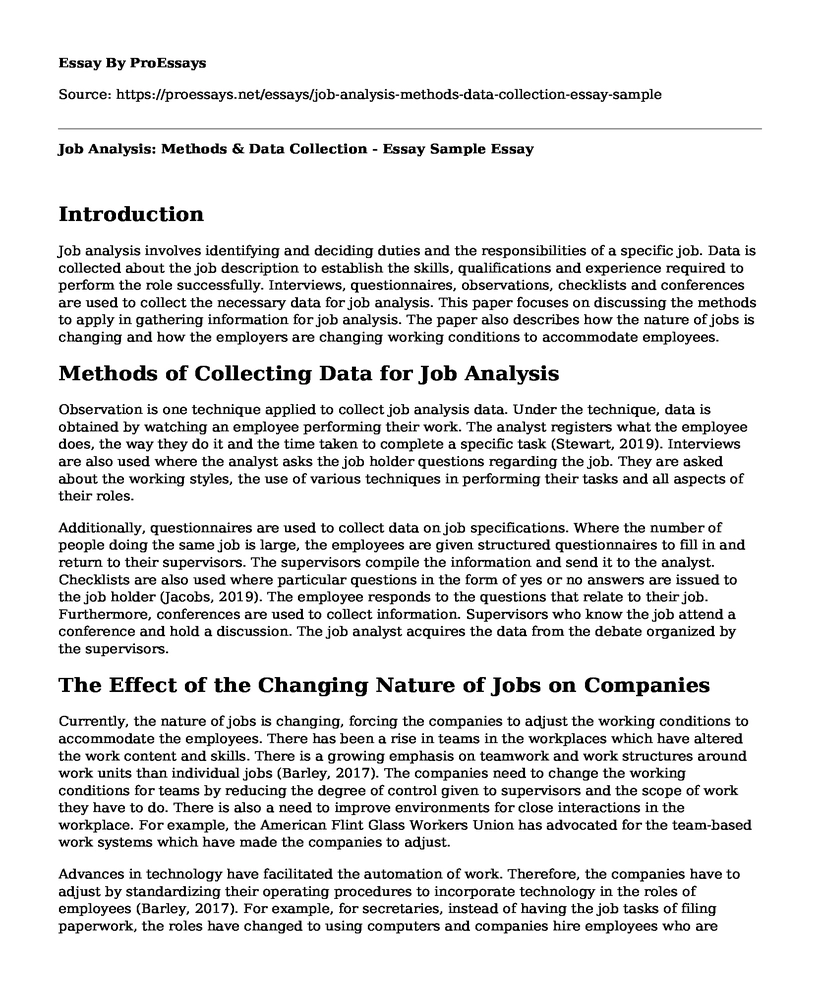Introduction
Job analysis involves identifying and deciding duties and the responsibilities of a specific job. Data is collected about the job description to establish the skills, qualifications and experience required to perform the role successfully. Interviews, questionnaires, observations, checklists and conferences are used to collect the necessary data for job analysis. This paper focuses on discussing the methods to apply in gathering information for job analysis. The paper also describes how the nature of jobs is changing and how the employers are changing working conditions to accommodate employees.
Methods of Collecting Data for Job Analysis
Observation is one technique applied to collect job analysis data. Under the technique, data is obtained by watching an employee performing their work. The analyst registers what the employee does, the way they do it and the time taken to complete a specific task (Stewart, 2019). Interviews are also used where the analyst asks the job holder questions regarding the job. They are asked about the working styles, the use of various techniques in performing their tasks and all aspects of their roles.
Additionally, questionnaires are used to collect data on job specifications. Where the number of people doing the same job is large, the employees are given structured questionnaires to fill in and return to their supervisors. The supervisors compile the information and send it to the analyst. Checklists are also used where particular questions in the form of yes or no answers are issued to the job holder (Jacobs, 2019). The employee responds to the questions that relate to their job. Furthermore, conferences are used to collect information. Supervisors who know the job attend a conference and hold a discussion. The job analyst acquires the data from the debate organized by the supervisors.
The Effect of the Changing Nature of Jobs on Companies
Currently, the nature of jobs is changing, forcing the companies to adjust the working conditions to accommodate the employees. There has been a rise in teams in the workplaces which have altered the work content and skills. There is a growing emphasis on teamwork and work structures around work units than individual jobs (Barley, 2017). The companies need to change the working conditions for teams by reducing the degree of control given to supervisors and the scope of work they have to do. There is also a need to improve environments for close interactions in the workplace. For example, the American Flint Glass Workers Union has advocated for the team-based work systems which have made the companies to adjust.
Advances in technology have facilitated the automation of work. Therefore, the companies have to adjust by standardizing their operating procedures to incorporate technology in the roles of employees (Barley, 2017). For example, for secretaries, instead of having the job tasks of filing paperwork, the roles have changed to using computers and companies hire employees who are computer literate. Moreover, there has been flattening of hierarchies in the organizations. The change has made employers reduce the number of managerial employees and delegate more power to low-level employees. The redefinition of roles has resulted in managers empowering the low-level employees and improved working conditions.
Conclusion
In job analysis, analysts collect data to determine the skills, qualifications and experience required to perform a given task. When collecting information, the analysts apply interview, questionnaires and observation techniques. They also use checklist and conferences to collect information. The nature of jobs has changed due to technological advancement and changing of hierarchical structures which have led to the redefinition of roles. Increased teamwork in the workplaces has also led to the adjustment of working conditions to accommodate the employees.
References
Barley, S. R., Bechky, B. A., & Milliken, F. J. (2017). The changing nature of work: Careers, identities, and work-life in the 21st century.
Jacobs, R. L. (2019). Job Analysis and the DACUM Process. In Work Analysis in the Knowledge Economy (pp. 63-79). Palgrave Macmillan, Cham.
Stewart, G. L., & Brown, K. G. (2019). Human resource management. Wiley.
Cite this page
Job Analysis: Methods & Data Collection - Essay Sample. (2023, Mar 11). Retrieved from https://proessays.net/essays/job-analysis-methods-data-collection-essay-sample
If you are the original author of this essay and no longer wish to have it published on the ProEssays website, please click below to request its removal:
- Analysis of Wayne Farm Case Paper Example
- MBA Career Goals Essay Example
- Research Paper on Groupware
- Min. Wage Debate: Raising the Bar for Low Wage Workers - Essay Sample
- Maximize Time to Maximize Money - Essay Sample
- Balancing Family, Work, and School: My Journey - Essay Sample
- Essay Example on Resolving Conflict: A Brain on Fire by Susannah Cahalan







